|
|
Friday Diversion: Apple Silicon on iPads; Benchmarking and Ethics; Expanding Watch and Health FeaturesBy Graham K. Rogers
With the arrival of the M2 chips Apple now has a firm lead in the ARM sector and a report from Strategy Analytics as outlined by Joe Wituschek (iMore) claims, amongst several other statistics, that Apple has a lead of some 2-3 years in this field. Another interesting revelation about the latest MacBook Air with the M2 chip is that it is apparently faster than the current, basic Mac Pro but at $5000 less (Joe Rossignol, MacRumors).There are of course other (more expensive) configurations of the Mac Pro that outperform the M2 still, but at the price the new Macs are impressive performers. So to produce a range of outputs that will make a Mac Pro a valid high end purchase, just what will power them when they are eventually released?
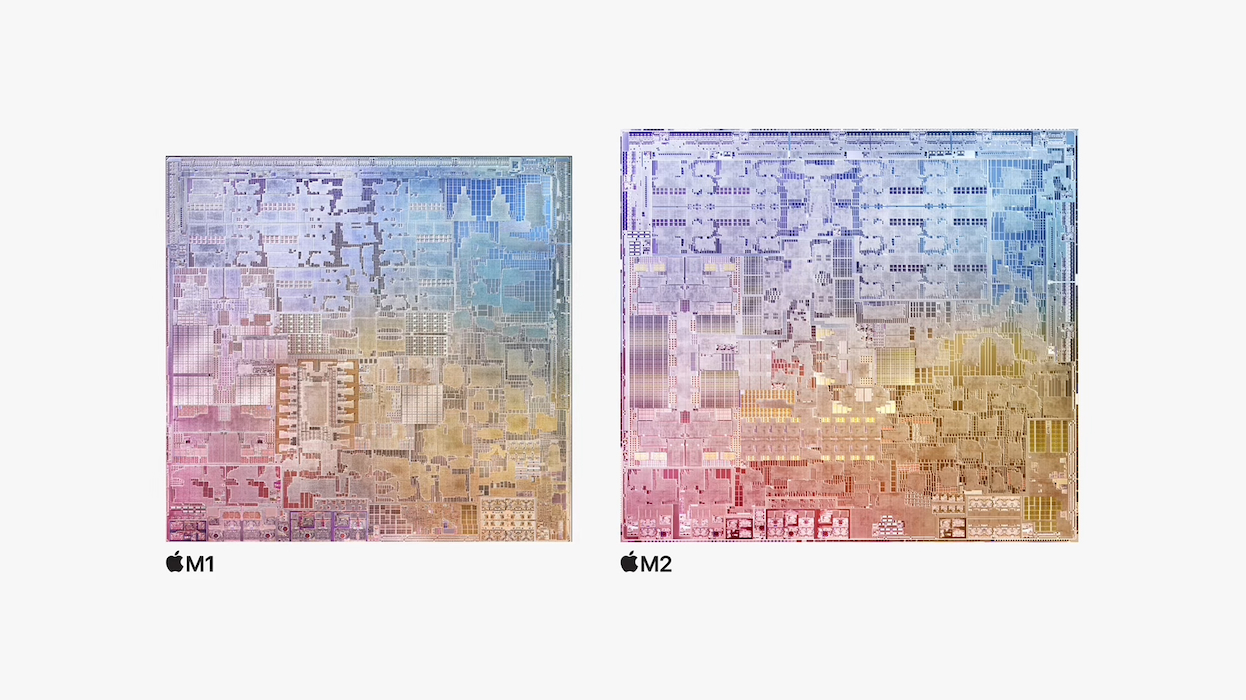
M1 and M2 chips - Image courtesy of Apple
Craig Federighi has been doing the rounds of online sources explaining how the power and memory management of the A-series iPads is not up to running the feature (Matthew Panzarino, TechCrunch). They tried in testing and it was not really viable. Tim Hardwick (MacRumors) reports on code found in the iPadOS beta that suggests Apple does have a way to test this. However testing in a lab and using on a day to day basis are something else. There is a considerable difference between the A-series chips and Apple silicon: the M1 and now M2 which is 20% more powerful (Juli Clover, MacRumors). I had the ability to compare the 11" M1 iPad Pro with the earlier version I had (arrived April 2019) that had the A12X Bionic chip. With the A-series version I was really happy with the performance for day to day activities. It changed the way I work. On most days I was able to leave the MacBook Pro at home. The only time I took the Mac to work was when teaching if I needed to run a presentation. I just prefer Keynote on the Mac. It works on the iPad of course, and (at a pinch) I have even run presentations using the iPhone, but in a class the Mac works better for me.
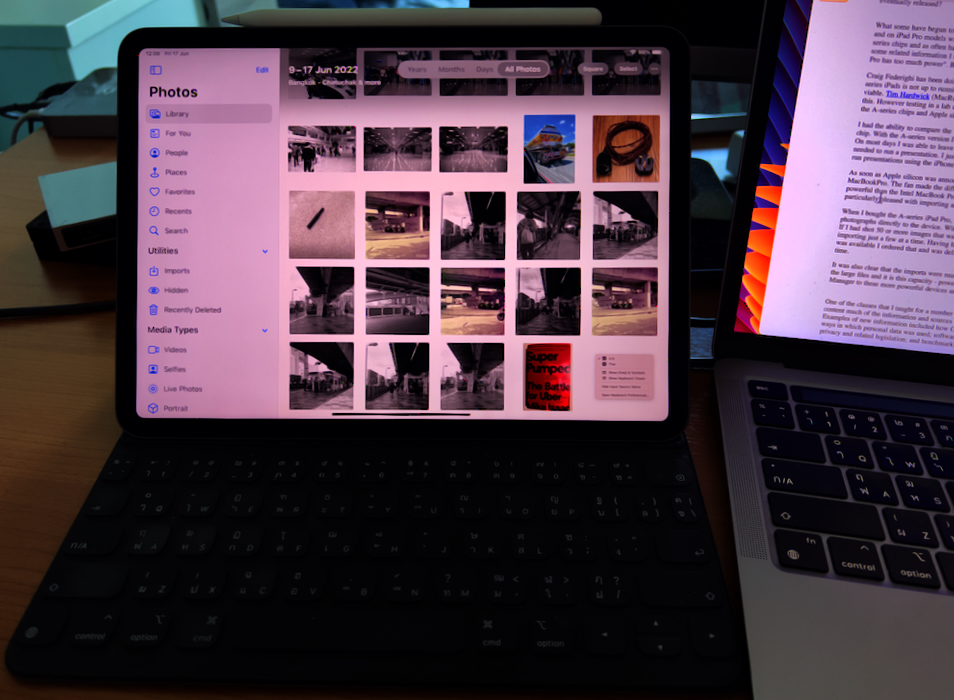
M1 iPad Pro (alongside M1 MacBook Pro)
When I bought the A-series iPad Pro, it was the first with the USB-C port. I could attach my camera and download photographs directly to the device. With the large RAW images however, the iPad would balk after about 10 were imported. If I had shot 50 or more images that was a problem. Once I understood that limitation, I worked round the problem by importing just a few at a time. Having had experience of the M1 chip with the MacBook Pro, as soon as the 11" M1 iPad Pro was available I ordered that and was delighted to find that it was able to import 50 or more photographs from the camera at a time. It was also clear that the imports were much faster: no time to make tea nowadays. That M1 chip was clearly able to handle the large files and it is this capacity - power and memory - that Apple silicon has that is behind the decision to limit Stage Manager to these more powerful devices and not have the features available but lagging on iPads with A-series chips.
I started the input on benchmarks with references to Volkswagen's "Dieselgate" as this was directly related to how computer engineers could make something right; or in this case, wrong. When the software in the car recognized that the motor was connected to emissions checking equipment, it would deliberately produce a low reading, so it appeared that emissions were lower than they really were. The original software was developed at Audi, but the whole VW group took advantage of this. It cost them billions and some executives were imprisoned. VW were not the only company that did this. Benchmarking is also used in computers and mobile phones. I used articles from AnandTech for part of this unit, particularly as one had a wonderfully titled table: "I Can't Believe I Have to Make This Table". Initially, Anand Lal Shimpi and Brian Klug started looking at Samsung Exynos phones but soon discovered that many Android handset manufacturers cheated, by "detecting the presence of certain benchmarks and raising thermal limits (and thus max GPU frequency) in order to gain an edge on those benchmarks." I was reminded of this when I saw this week that Samsung had been found "cheating by designing its TVs to recognize and react to test patterns used by reviewers". Rasmussen Larsen (FlatpanelsHD) explains how reviewers use specific window sizes when examining color output on flat screens, like 10%. However, when a non-standard window (9%) is used, "the TV reveals its true colors". The article contains explanations and images of testing software that shows how this is done. Samsung will update its algorithm, we are told. Larsen comments that it sounds "as if Samsung will expand its cheating algorithm to cover more window sizes, but this is obviously something we will examine again in future reviews."
They were caught then lied to Apple about what they would do to redress the situation and were taken to task more than once by Eddy Cue. Patently Apple used this as an example of how antitrust bodies in the U.S. and Europe setting out to force Apple to accept sideloading would lay users open to risks. Unfortunately, Showtime is not available here, but the series was based on a book by Mike Isaac. I ordered that and it arrived this week. Even the prologue has enough to indicate that If I were still teaching Ethics and Morals I would add this to the reading list. It is a long book, but I am looking forward to working through this.
Once a potential problem is spotted the Commission goes all out to prove that, and its a priori approach (accepting "certain propositions independent of any evidence, perhaps because they are reasonable presuppositions of some area of inquiry" Stanford) dilutes arguments against their ideas. Only the evidence that proves what you want is used. This is what some contend has been happening with Apple and other US tech companies that have been in Vestager's sights. The Court has already overturned massive cases against Apple and Intel, and now Qualcomm. Perhaps there is a lesson here for Margrethe Vestager.
A few hours after sending Feedback, Oliver Haslam (iMore) wrote about this change and notes that this has confused a lot of people. I am less confused than annoyed. The flags were a nice touch; the characters are soulless. The change may be due to an internal Apple decision, but as Haslam notes, "that's a shame because the best Mac is one that people don't have to rework years of muscle memory to use." Remember the motorcycle maintenance rule, If it ain't broke, don't fix it.
I find it useful to monitor a number of factors: sleep, heart rate, blood-oxygen levels and exercise. On the Health App I also look at weight and (recently) water intake. I also make occasional use of the ECG (electrocardiogram) feature on the Apple Watch, but I am aware that this is not for diagnosis. However, if it indicated a problem, especially if other inputs were not normal, I would consider visiting a health expert.
With the sensors in the Watch, it is easy to detect motion: the handwashing feature uses this, along with detecting the sound of running water. Motion is also used in Fall Detection and I have sometimes triggered this by rapid movement in an office chair, or other sudden turning movements. I have had to stop the Watch phoning for help on a couple of occasions, but I would rather it err on the side of safety than not work if I did fall. Patently Apple reports on another use of motion sensing in the Apple Watch. A San Francisco startup has received FDA approval to "use the Apple Watch to monitor tremors and other common symptoms in patients with Parkinson's disease." Data from the Watch will be used with information from an implant that measures brain signals. It is noted that normally observation only takes place in a brief visit to the doctor, while this system "will give doctors a continuous stream of observations over long stretches" and so allow fine-tuning of treatment for patients: precision medicine.
Graham K. Rogers teaches at the Faculty of Engineering, Mahidol University in Thailand. He wrote in the Bangkok Post, Database supplement on IT subjects. For the last seven years of Database he wrote a column on Apple and Macs. After 3 years writing a column in the Life supplement, he is now no longer associated with the Bangkok Post. He can be followed on Twitter (@extensions_th) |
|

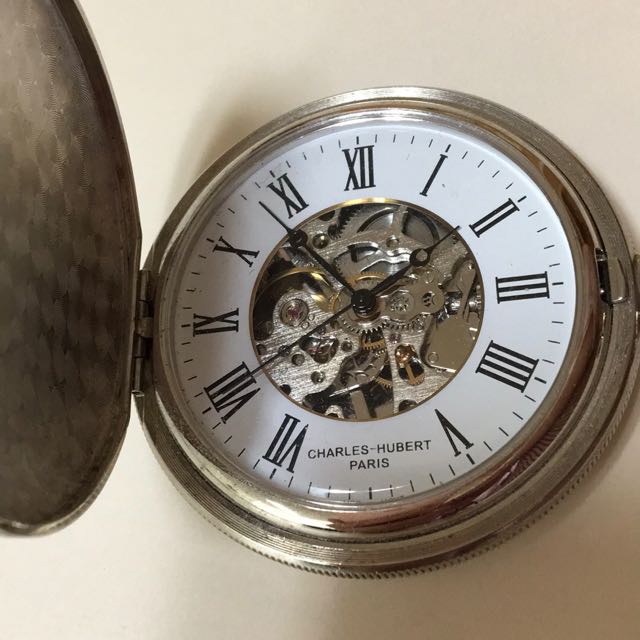
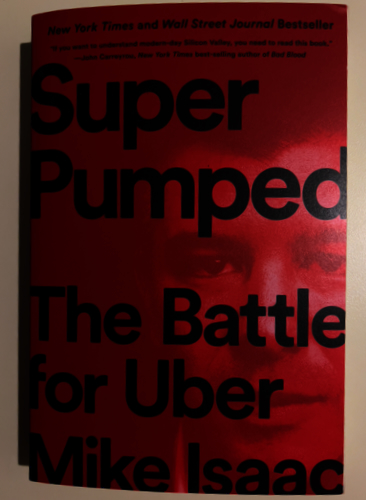 A couple of weeks ago, I was interested in information about a Showtime documentary on
A couple of weeks ago, I was interested in information about a Showtime documentary on 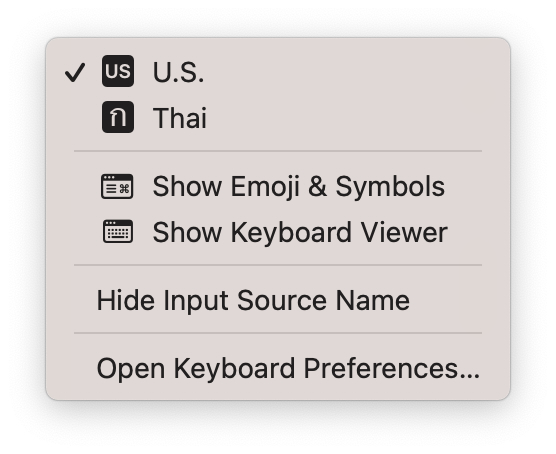 The flags provide an easier way to identify the menu itself, especially if the language has changed (I touch the wrong keys sometimes while typing), while characters take time (albeit small) to process - that is the beauty of icons. There are some suggestions on the StackExchange page, but the most useful is for users to provide feedback. I did that.
The flags provide an easier way to identify the menu itself, especially if the language has changed (I touch the wrong keys sometimes while typing), while characters take time (albeit small) to process - that is the beauty of icons. There are some suggestions on the StackExchange page, but the most useful is for users to provide feedback. I did that.
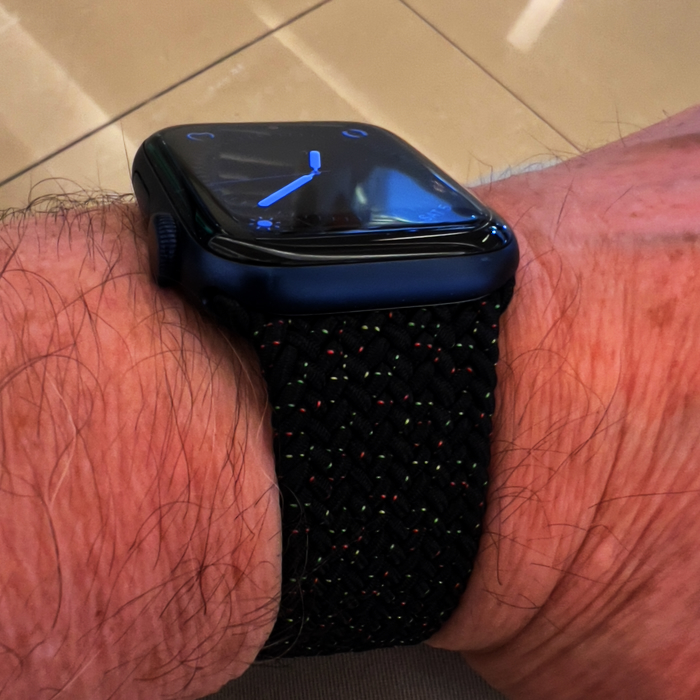 There are a number of other ways in which Health and the Watch could help, although some are limited currently. Diabetes is checked by drawing blood, but there is now continuous glucose monitoring: sensors are placed under the skin and communicate with a monitor. Some work with the iPhone and I saw one if these in use at WWDC last time I went there in 2016. The hope is that at some stage non-invasive checking for glucose levels will be developed, but that is still to come.
There are a number of other ways in which Health and the Watch could help, although some are limited currently. Diabetes is checked by drawing blood, but there is now continuous glucose monitoring: sensors are placed under the skin and communicate with a monitor. Some work with the iPhone and I saw one if these in use at WWDC last time I went there in 2016. The hope is that at some stage non-invasive checking for glucose levels will be developed, but that is still to come.
